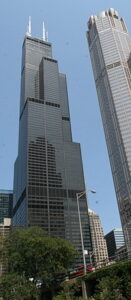Introduction:
Many skyscrapers may feature protruding elements on their roofs that serve different purposes. Two common rooftop structures are spires and antennas. While both structures may appear similar from a distance, they have other functions and designs. This essay will explore the differences between building spires and antennas.
The Feud Between Spires and Antennas

When the new One World Trade Center (AKA Freedom Tower) in New York City was completed, the owners laid claim that this was the tallest building in the western hemisphere, rising to a symbolic height of 1,776 feet. The number represents the year the Declaration of Independence was created.

But all is not rosy when the owners of the Chicago Willis Tower had something to say about it. They claimed that the 408-foot steel attachment that was placed on the top of the Freedom Tower should not count and subsequently, the 1,451-foot Willis Tower should still be considered the tallest building in the western hemisphere.
Interesting note: The Empire State Building has a spire and an antenna!
Enter The Council of Tall Buildings
Someone needed to step in and resolve this and the international non-profit Council of Tall Buildings did just that and their conclusion was that the Freedom Tower is the tallest.
Reason is that there is a difference between a spire and antenna and spires count. Antennas don’t, of which they concluded that One World Trade Center has a spire.
Now let’s take a look and see why this is the case.
Function
The primary function of a building spire is to enhance the aesthetics of the structure. Spires can add architectural interest to a building and make it stand out in a cityscape. They come in different shapes and sizes and can be made from various materials, such as metal or stone. Spires can also have religious or symbolic significance, as they are often found in churches or other historical buildings.
Antennas, on the other hand, have a functional purpose. They are designed to transmit or receive electromagnetic waves, such as television or radio signals. Antennas can also be used for communication purposes, such as transmitting mobile phone signals or internet data. They are typically made of metal and are shaped to optimize the reception or transmission of waves.
Design
Spires and antennas have distinct designs that reflect their functions. Building spires are often ornamental and decorative and conform to the building’s architecture or aesthetic design.
They can be designed in various shapes and sizes, such as a pointed Gothic spire or a round domed spire. Spires are typically made of materials that can withstand weather and environmental factors.
Antennas, on the other hand, have a practical design that is optimized for their function. The shape of an antenna is critical to its performance in capturing or emitting electromagnetic waves.
Antennas can be designed in different shapes, such as a Yagi antenna or a dipole antenna, depending on the specific frequency range they are intended to operate within. The size and placement of an antenna are also crucial factors that can affect its performance.
Location
Spires and antennas are located on different parts of a building. Spires are typically located at the top of a building, either on the roof or on a tower. They are often used to create a distinctive silhouette or to draw attention to the building. Spires are usually visible from a distance, which makes them an essential part of a building’s architecture.
Antennas, on the other hand, can be located anywhere on a building’s roof or facade. The location of an antenna depends on various factors, such as the type of signals it is designed to capture or transmit and the obstacles in the surrounding area. Antennas can also be located on poles or towers outside of a building.
Regulation
The regulation of spires and antennas differs. Building codes typically regulate the design and construction of spires. There may be height restrictions or other regulations that limit the size or shape of a spire. Spires may also be subject to aesthetic guidelines to ensure they fit in with the surrounding architecture.
Antennas, on the other hand, are subject to a different set of regulations. In many countries, the construction of antennas is regulated by government agencies, such as the Federal Communications Commission (FCC) in the United States. These agencies are responsible for ensuring that antennas are safe and do not interfere with other electronic devices or signals. Antennas may also be subject to zoning regulations that limit their size or placement.
Conclusion
In summary, while building spires and antennas may appear similar from a distance, they have different functions, designs, locations, and regulations. Spires are decorative elements that enhance the aesthetics of a building, while antennas are functional structures that capture or emit electromagnetic waves.
The design of a spire is ornamental, while the design of an antenna is optimized for its function. The location of a spire is typically on the roof or tower of a building, while the location.
And there lies the reason why the Freedom Tower stands to be the official tallest building in the western hemisphere.
